Smygehuk in Skåne is Sweden's southernmost cape. There is a small harbour, some cosy little restaurants and beautiful nature. Above all, there are a number of signs that clearly indicate that you are at the southernmost point in Sweden.
Table of contents
Smygehuk
Smygehuk is located at the town of Smygehamn, east of Trelleborg on the south coast of Skåne, and belongs to the municipality of Trelleborg. Even though the place is small, it is a popular destination for tourists. Who doesn't want to be able to say they've been to Sweden's southernmost headland?
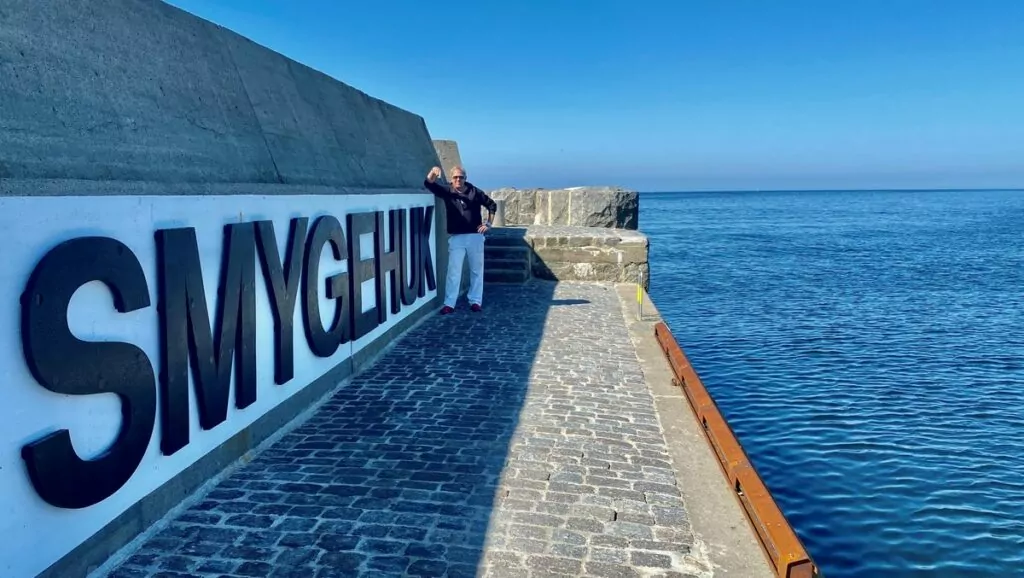
Sweden's southernmost cape
At the waterfront in Smygehuk there is a viewing platform which is the southernmost point in Sweden - 55 degrees 20 minutes 13 seconds. Just behind it is a compass rose indicating the distance to different places in the world.
Even though we were early in the morning, and even though it was not yet the real high season, we had to queue for a little while to take the top picture. First we had to help some German cyclists to immortalise themselves on the spot.

Nearby, there are fixed binoculars where you can look out over the sea and the passing boats.
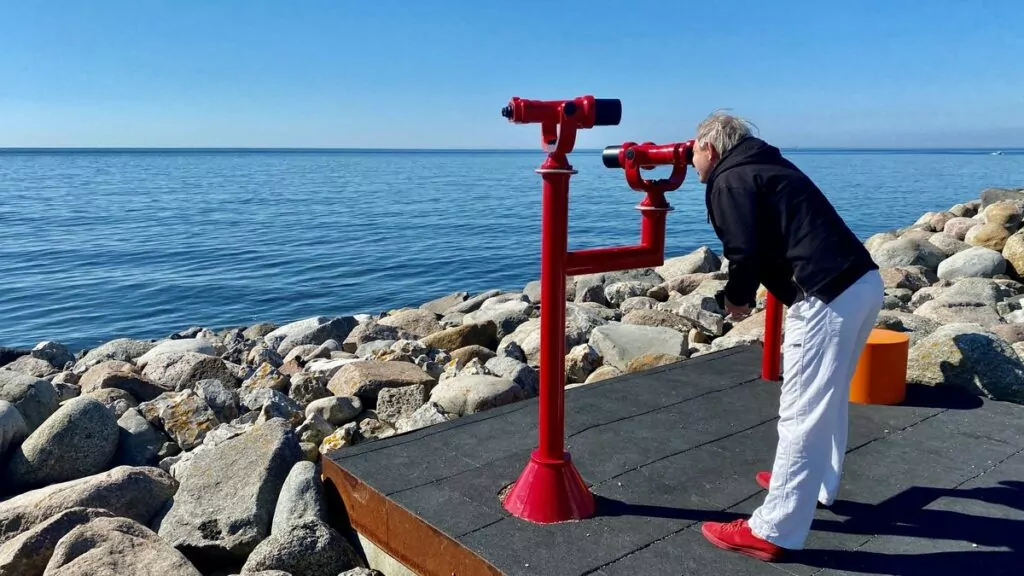
Protected snakes
It is not only people who like to visit Sweden's southernmost point, but also vipers. There is apparently a unique population of vipers here and the snakes are protected. We didn't see any snakes, but to be honest, we were just as happy about it.
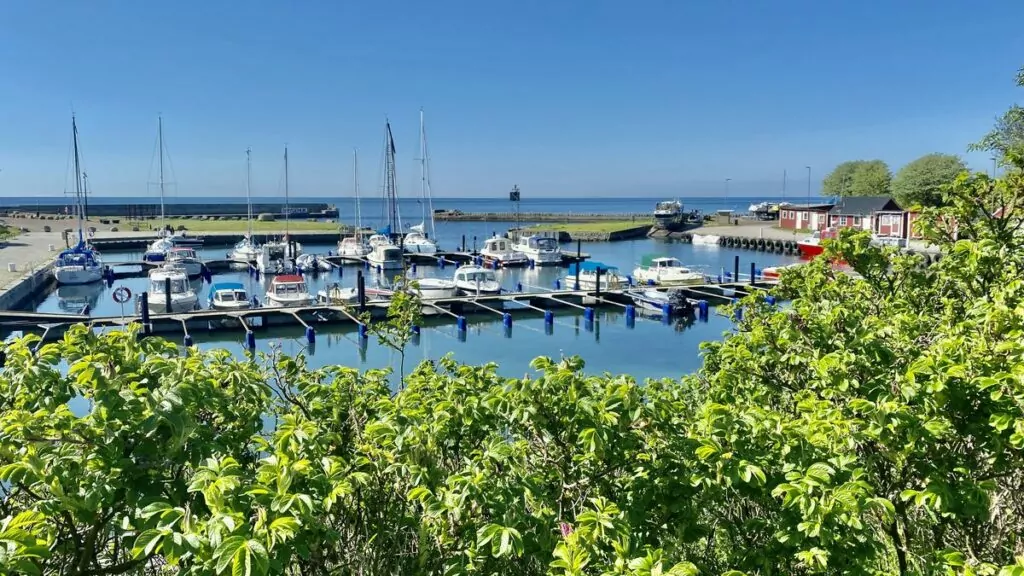
The warehouse and memories of the lime industry
In Smygehuk there are a number of buildings and places that are reminders of history. These include the Köpmansmagasinet, which was built in the early 19th century and was one of four trading estates in the area. Today the building houses craftsmen and artists.
We could also see a lime kiln, built in the middle of the 19th century. At this time, the mining and burning of lime, along with fishing and trade, was one of the major industries in the area. The burnt lime was used as a soil improver and as a building material. Today, the reservoir and kiln are reminders of times gone by.
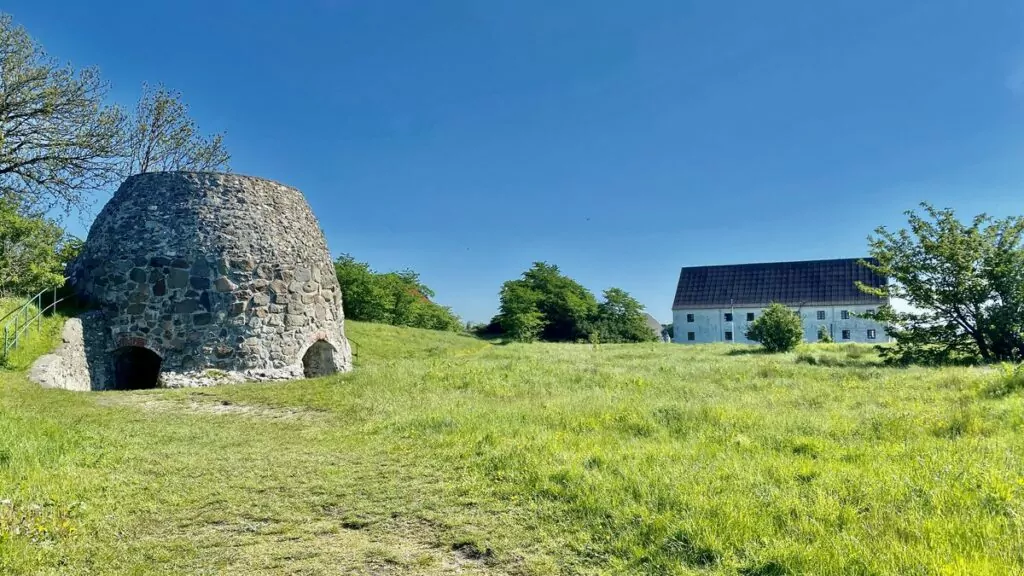
The harbour in Smygehuk
The harbour in Smygehuk is charming, full of small boats and harbour sheds (hoddor) where fishermen store their gear. There has been a small fishing village here since the 17th century. The harbour was built in the 1920s to facilitate loading and unloading.
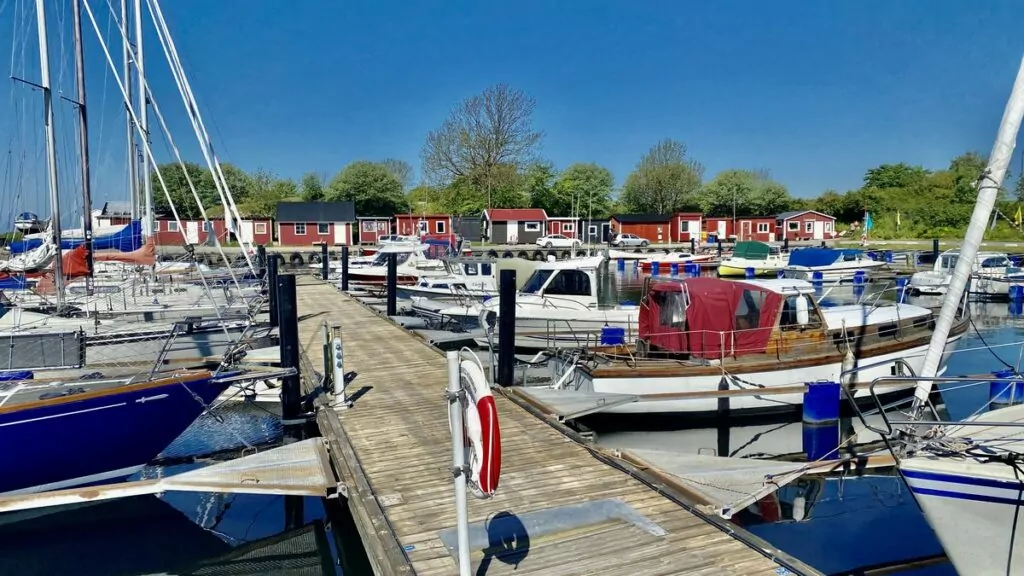
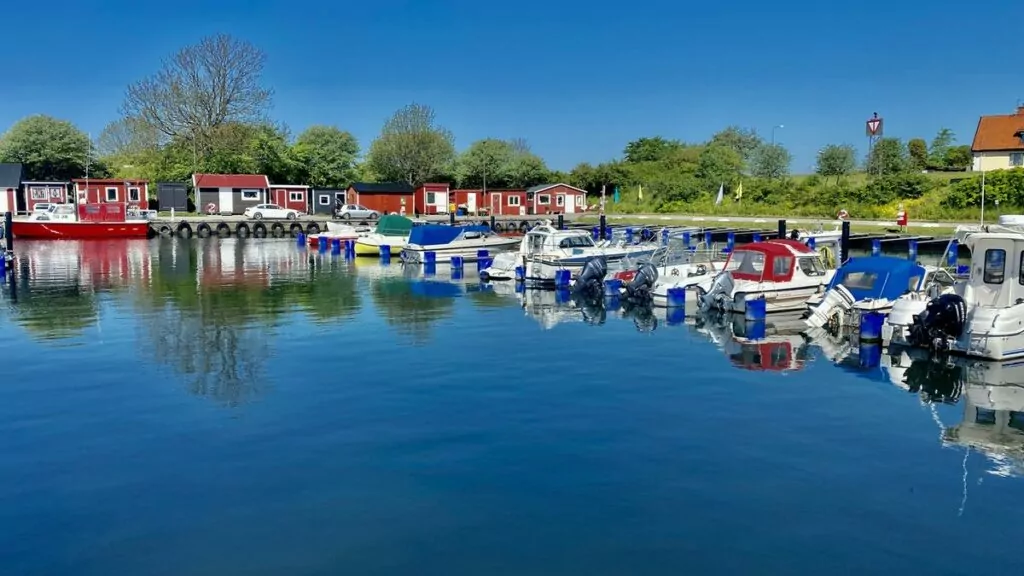
West of the harbour there is also a lighthouse (which we never photographed). Smygehuk's lighthouse was built in 1883 and is a 17 metre high iron tower. After being extinguished for 25 years, it was relit in 2001 and now guides pleasure boats and local fishermen around the headland. Next to it is an old lighthouse keeper's house, now used as a hostel.
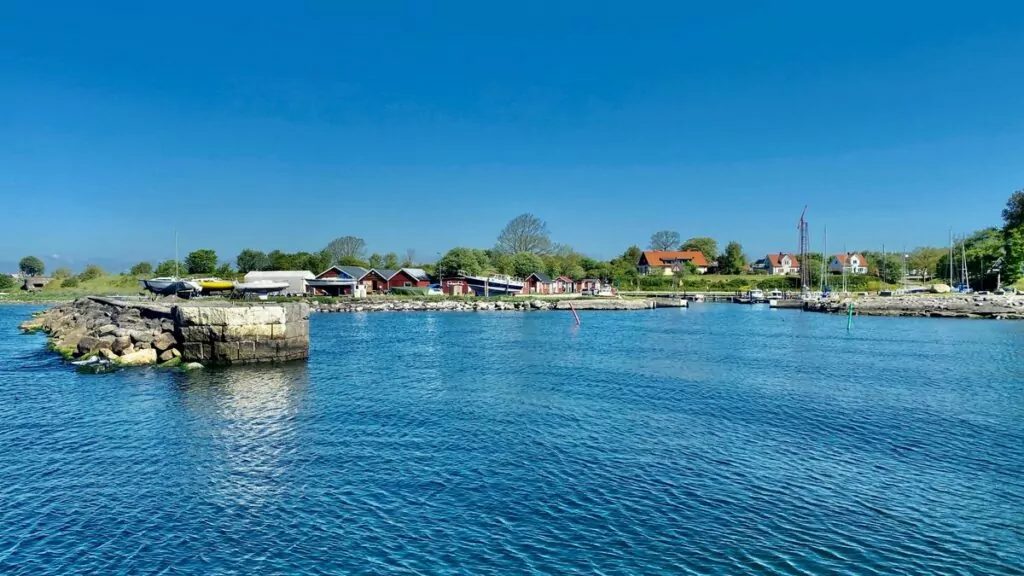
Cafés, eateries and shops
There are several food services in Smygehuk. We were here a little too early in the morning for them to be open, but we saw a fish smokehouse, Café Smyge and ice cream parlour.
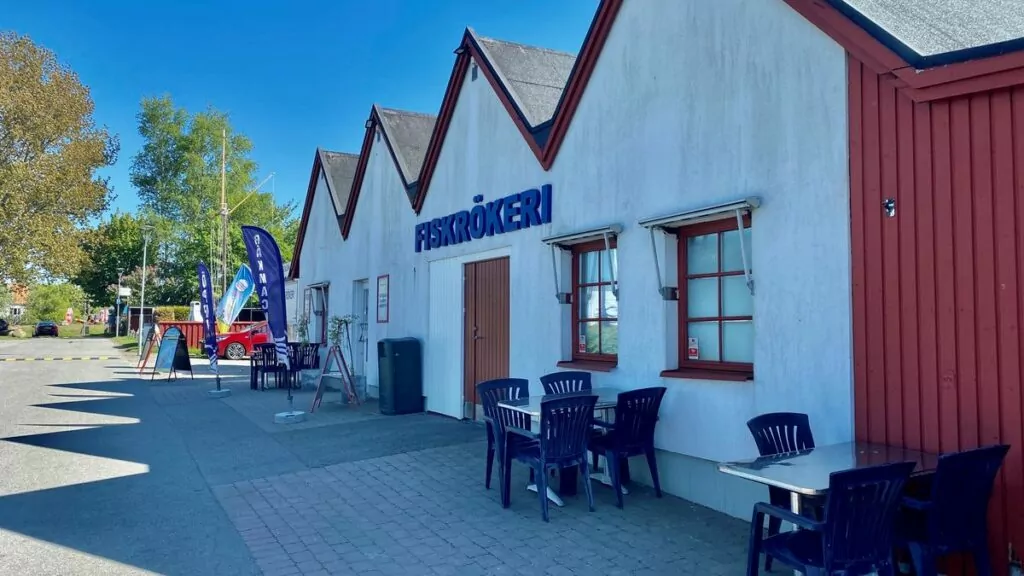
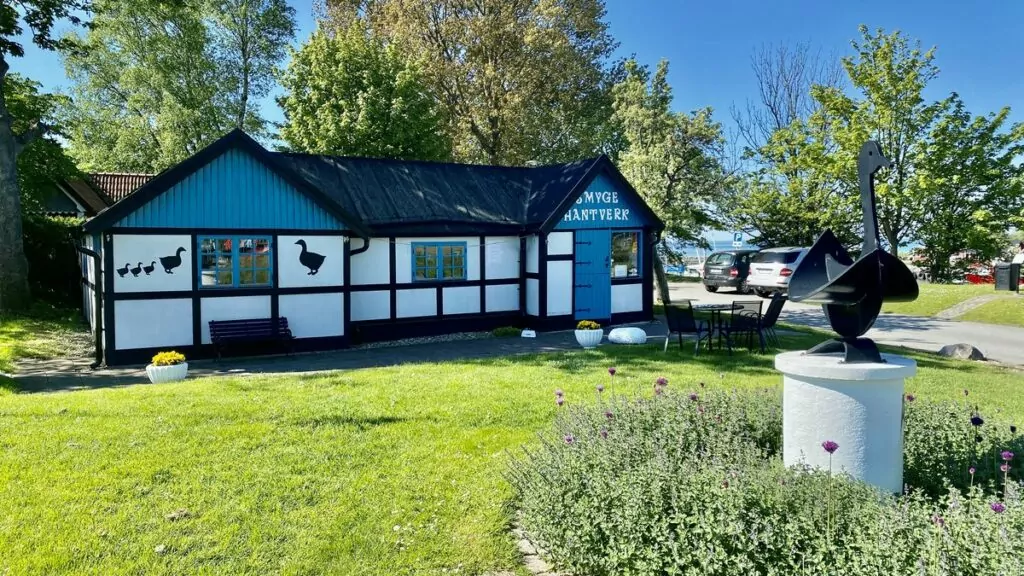
Works of art and (violent) history
As you wander around the area around Smygehuk, you come across some works of art. In the photo, Peter is peering into part of an installation called 'Euphoria of the Senses', which is about the encounter with the sea.
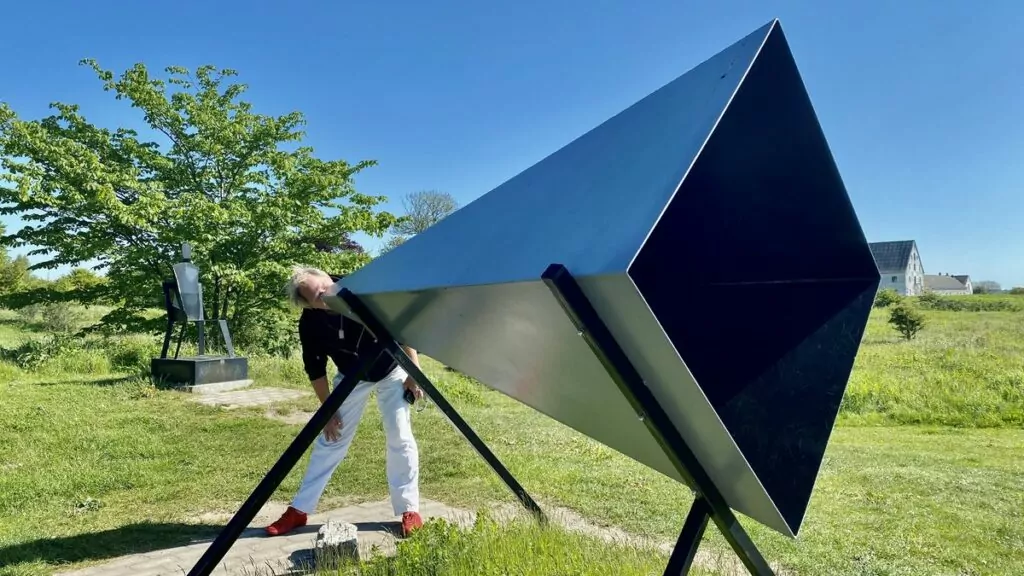
One piece of artwork that can be seen from the road is a statue of a woman, stretched out towards the sea and the wind. The sculpture was made by Axel Ebbe and is called 'Famntaget'. Rumour has it that actress Uma Thurman's grandmother was once the model for the piece.
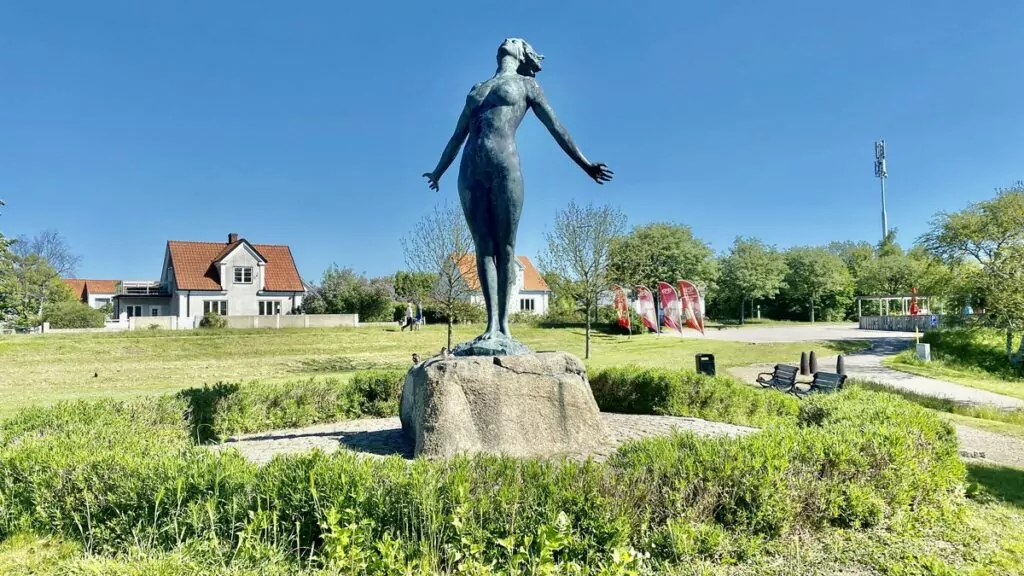
We also checked out a stone labelled 'Sly Stone'. What could this be? As we were looking around, a man passed by and said that "at that stone many men have lost their lives". And so it was apparently, that this stone was used in a whole series of executions, in the past.
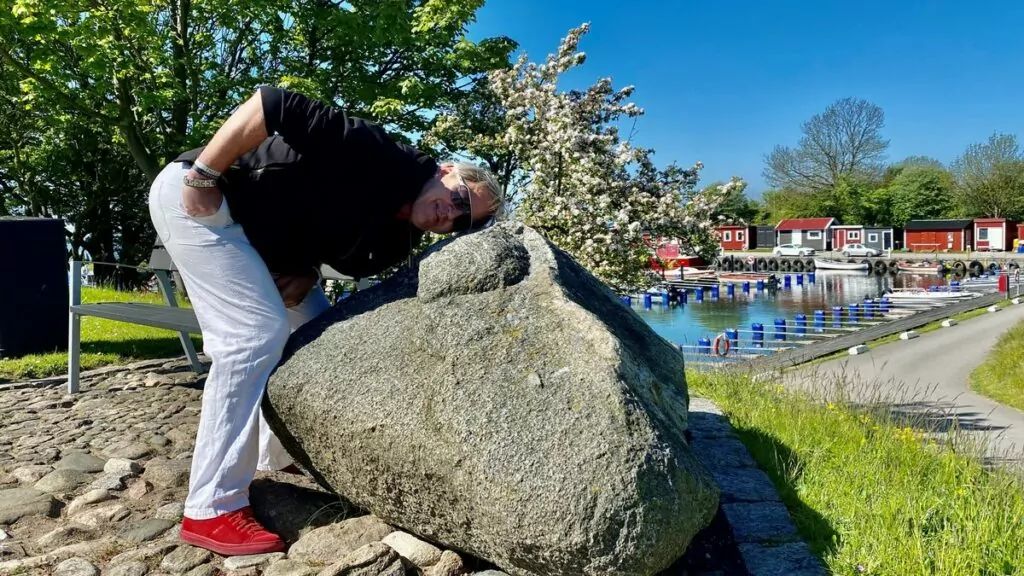
See more around Smygehuk
In the neighbourhood of Smygehuk, you can take the opportunity to visit Trelleborg with "Trelleborgen" and Ystad with its charming historic neighbourhoods. It is also not far from Skanör and Falsterbo with its long beautiful beaches, with soft fine-grained sand.
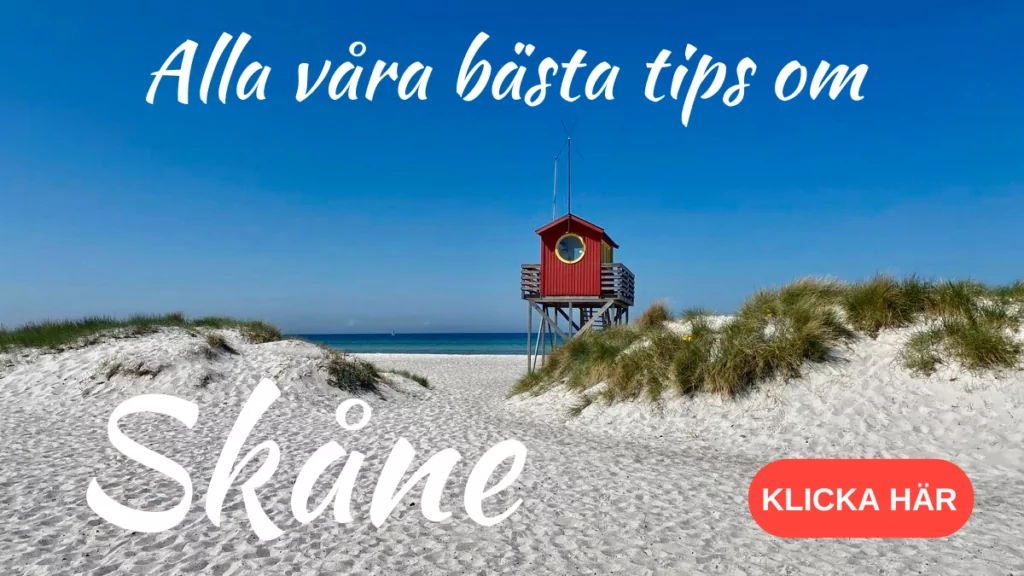
Trip to Malmö - a surprise from Peter to Helena
Writer: Helena Bergström We have made a trip to Malmö! A while ago, we declared...
An evening of music at Diggiloo in Ystad
Guest writer: Pernilla This summer, Diggiloo will play 24 concerts in 24 different cities in Sweden, in...
A day at Bongska Huset and its big sister Hotel Mossbylund
Guest writer: Pernilla Bongska The house in Abbekås is nicely located in Abbekås harbour in Skåne, near the beach...
Everyday luxury at Hotel Dannegården in Trelleborg.
Guest writers: Magdalena and Pernilla Travelling and long-distance adventures are great. Everyday luxury in your neighbourhood should...
Stationen Ystad - cosy bed & breakfast in Skåne
Stationen Ystad is a really cosy Bed & Breakfast in Skåne. Peter and his brother...
The Swedish Skåne Road - FREEDOMtravel Themed Road
Writer: Peter Bergström The Swedish Skåne Road is a themed road that takes you through Skåne,...
Things to do in Malmö - 28 sights and experiences
What to do in Malmö? This Scanian city has a lot to offer, in...
Street art in Malmö - a guide to Malmö's street art
Street Art in Malmö! It can be called street art, street art, wall paintings, murals or simply...
Disgusting Food Museum in Malmö - a "disgusting" visit
The Disgusting Food Museum in Malmö is for those who want to shudder and think "What...
With a camper in Malmö - tips on pitches and experiences
By motorhome in Malmö! We paid a visit to Sweden's third largest city with...
Things to do in Helsingborg - 20 sights and experiences
What can you see and do in Helsingborg? Helsingborg is a lovely Scanian city with...
Ramlösa brunnspark - from health resort to mineral water
Ramlösa Brunnspark in Helsingborg has a history that goes all the way back to the 17th century, when...
Fredriksdal in Helsingborg - museums and gardens
Fredriksdal in Helsingborg, or Fredriksdal Museum and Gardens, is a nice open-air museum in Skåne. Here you can...
Things to do in Ängelholm - our 9 best tips
What to see and do in Ängelholm? Ängelholm is a charming little town in Skåne...
Northeast Skåne - 6 excursions by car from Kristianstad
Writer: Helena Bergström Northeastern Skåne offers beautiful nature, charming towns and several exciting excursion destinations....
Excursions on the Bjäre Peninsula - 8 wonderful experiences
Excursions on the Bjäre Peninsula will be about today. At the risk of repeating ourselves a little ...
Kullahalvön and Kullaberg nature reserve
Kullahalvön, or Kullen as the peninsula is also called, is located in north-west Skåne. Here you will find ...
Swedish vineyards - 4 farms with Swedish wine
Do Swedish vineyards exist? Yes, they do, and Swedish wine is on the rise...
Krapperup Castle in Skåne - with castle park and coffee house
Krapperup Castle is a Scanian estate dating back to the 14th century. Today there is a beautiful castle...
Birgit Nilsson Museum - starry-eyed in the Scanian soil
Birgit Nilsson Museum tells the story of the farmer's daughter who became a world star. Sometimes reality surpasses poetry, and...
Norrviken's gardens - fantastic park outside Båstad
Norrviken Gardens, located outside Båstad in Skåne, was built at the end of the 19th century by gardening enthusiasts....
Båstad with a motorhome - are you welcome?
Båstad with a motorhome - are you welcome? Yes, you could ask yourself that. The feeling in...
Artwork Nimis - directions and interesting facts
Nimis is a fascinating artwork on the Kulla peninsula in Skåne, created by artist Lars Vilks. It...
Höganäs in Skåne - the ceramics town on the west coast
Höganäs is located in north-west Skåne, on the Kullen peninsula, and is probably for most...
Tropicarium in Helsingborg - exotic animals from around the world
Tropikariet in Helsingborg, Sweden, is an exotic indoor park that showcases fascinating animals from...
Sofiero castle and gardens - royal floral splendour!
Sofiero Castle and Castle Garden in Helsingborg offers a fantastic environment with intense greenery, splendour and...
Råå - picturesque in the south of Helsingborg
Råå is a charming old fishing village in southern Helsingborg. Today this is a picturesque coastal community...
Things to do in Landskrona - 12 sights and experiences
What to see and do in Landskrona? Landskrona is a pleasant town on the Öresund...
What to do on Ven in Skåne - 10 tips for a scenic island
What to see and do on Ven? This scenic island is located off the west coast of Skåne,...
Jakriborg in Skåne - inspired by the Middle Ages
Jakriborg is a residential area on the Scanian plain, just south of Lund, which looks like...
What to do in Ystad - 12 tips for experiences and attractions
What to do in Ystad? We have visited Ystad several times, but never so...
What to do in Lund - 16 tips for sights and experiences
What to do in Lund? This Scanian university town is characterised by students, research and youthful...
Dalby South Forest - Europe's smallest national park
Dalby Söderskog National Park is Europe's smallest national park. The nature area is located outside Lund in Skåne and is...
Culture in Lund - an open-air museum in the city centre
Kulturen i Lund is an open-air museum that extends over two blocks, right in the centre of...
Sandhammaren in Österlen - a beautiful sandy beach
Sandhammaren in Österlen is a beautiful sandy beach with soft, fine-grained sand, which has been...
What to do in Trelleborg - our 9 best tips
What to do in Trelleborg? Sweden's southernmost city has become known as the 'Palm City',...
Glimmingehus - Scandinavia's best preserved medieval castle
Glimmingehus in Skåne is the best preserved medieval castle in the Nordic region. Construction of the castle began in the late 15th century,...
Ales stones - an ancient mystery in Skåne
Ales stenar is Sweden's largest and best preserved shipbuilding site. The stone formation sits magnificently on a hill...
Skanör - sandy beach, finger food and a blog session
Skanör is located at the bottom of southeastern Skåne and offers fantastic sandy beaches and cosy restaurants....
FRS Baltic - from Trelleborg to Sassnitz in less than 2.5 hours
FRS Baltic takes you from Trelleborg to Sassnitz in less than 2.5 hours, with its high-speed...
Kronovalls castle - a beautiful wine castle in Skåne
Kronovall Castle is a stunningly beautiful baroque castle in Österlen, Skåne. Today the castle serves as...
Kristianstad - 17 things to do and experience
Kristianstad, and the area around Kristianstad, offers everything from castles and charming farms to lovely...
Cosy accommodation in Skåne - close to nature at Cocoon meetings
In May this year we stayed one night in a fantastic cosy accommodation in Skåne....
Ivön and Bäckaskog Castle in Skåne - the hunt for the horse grave
Ivön and Bäckaskog Castle in Skåne are located just north-east of Kristianstad. We were here one...
Åhus in Skåne - a holiday resort with vodka and ice cream
Åhus in Skåne is a lovely holiday resort, which is known for its Absolut...
Absolute Home - a visit to The Åhus villa
We visited Absolut Home and The Åhus Villa in Åhus, Skåne. Here we have...
Have you visited Smygehuk and Sweden's southernmost headland? Do you have any other tips on what to see and do in the neighbourhood? Let us know!
Facts about Smygehuk - Sweden's southernmost cape
- Municipality: Municipality of Trelleborg
- County: Skåne County
- Landscape: Skåne
- Location: The south coast of Skåne, near Smygehamn.
- The name: The prefix 'Smyge' is from the Scanian language and means narrow passage or sheltered area. The suffix 'Huk' is borrowed from Dutch and means headland.
- Read more: You can find more information at Visit Trelleborg.
Services and practical information
- Toilets: Free toilets are available in the area. There is also the possibility of emptying latrines. The toilets are not open 24 hours a day.
- Food service: There are several different food outlets, including a fish smokehouse and ice cream parlour.
- Tourist information: The Smygehuk tourist information centre is located in the harbour.
Animals and nature at Smygehuk
- Geology: Animals and nature in the area are characterised by the calcareous soil. Here you can also find fossils of sea urchins that lived almost 100 million years ago.
- Plants: The calcareous soil is home to, among other things, backanis, watercress and crabgrass. North of the harbour there is a marsh where orchids such as mayweed and meadowsweet thrive.
- amphibians: At Smygehuk there are newts, frogs and toads, including the endangered common toad.
- Ormar: The coastal meadows between Böste and the harbour in Smygehuk are home to a unique population of vipers. The snakes are protected.
Find your way to Smygehuk
- Car: Follow road 9 from Ystad or Trelleborg.
- Bus: Skånetrafiken bus line 190. In summer, the Palm Bus also runs from Trelleborg to Sweden's southernmost cape.
- Bicycle: There is a cycle path along the coast.
History in Smygehuk
- 17th century: Smygehuk and the town of Smygehamn developed as a fishing community, due to the rich fishing and fertile soil.
- 19th century: Four large trading centres were built, of which Köpmansmagasinet was the largest. Limestone mining, fishing and trade were the most important industries in Smygehamn. At the end of the century, lime mining and burning became an industrial activity.
- Early 20th century: Thanks to the railway, Smygehamn became a seaside resort. First the Östra Torp Strandhotell was built and later the Hotell Smygehus.
- Mid-20th century: The lime industry was no longer profitable, and instead the number of fishermen increased. The railway kept trade moving.


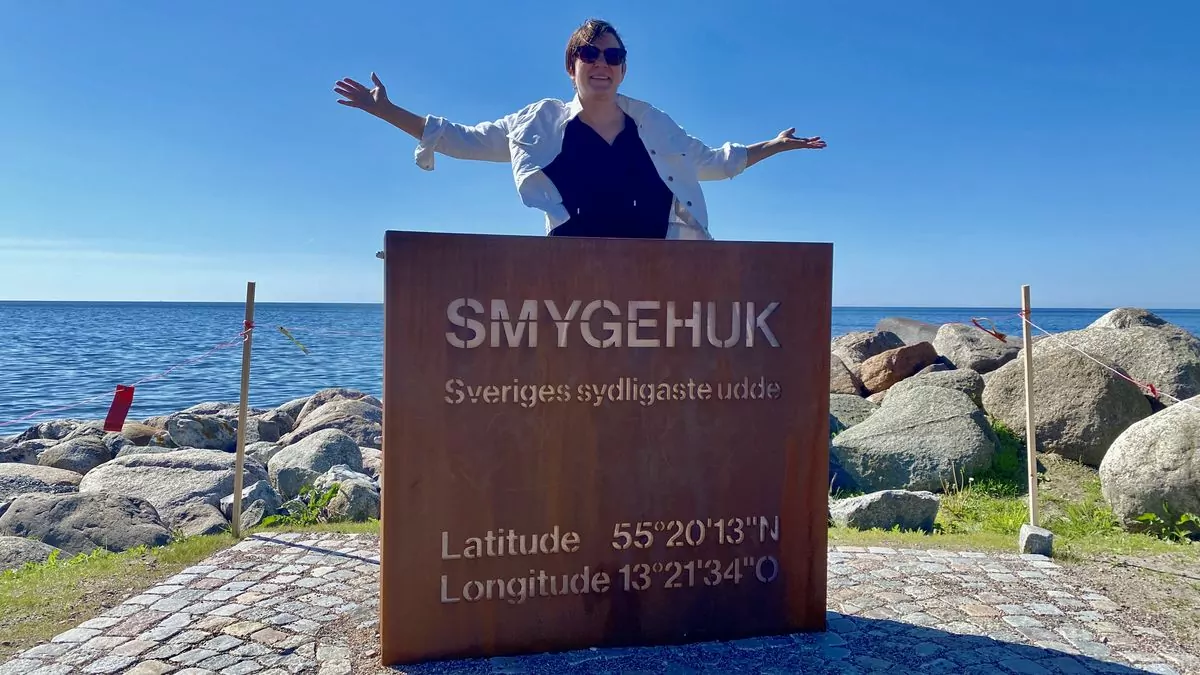






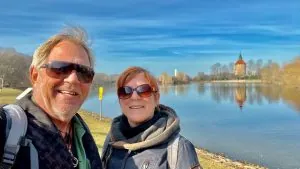

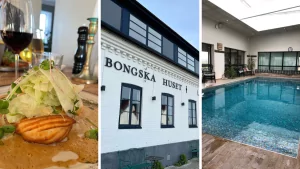
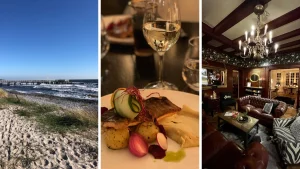
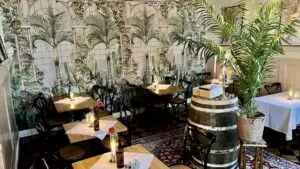
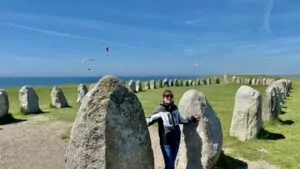
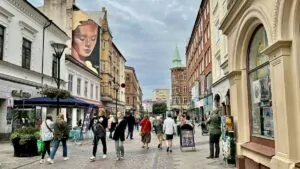

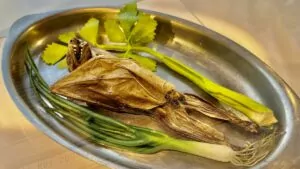
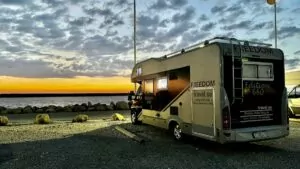
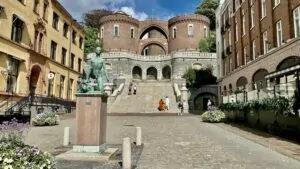
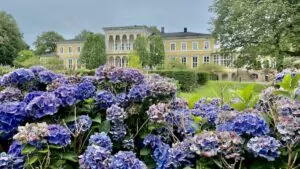
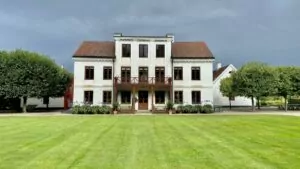
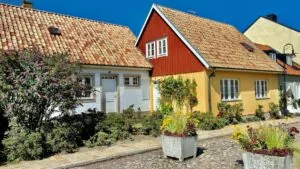
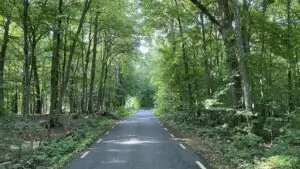
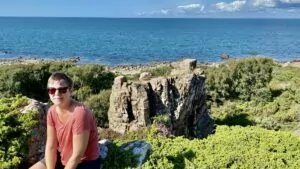
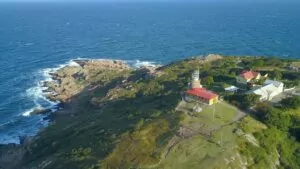
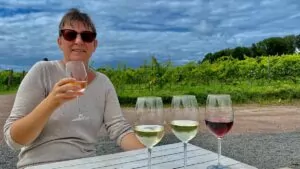
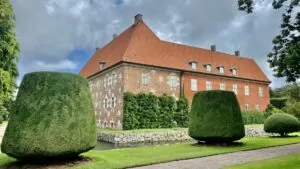
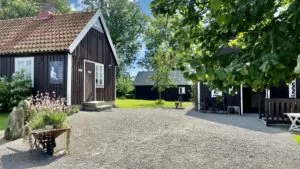
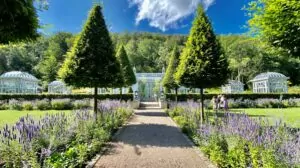
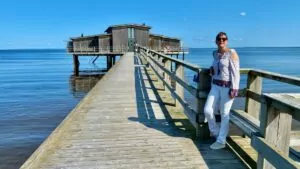
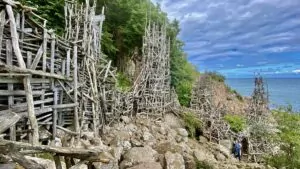
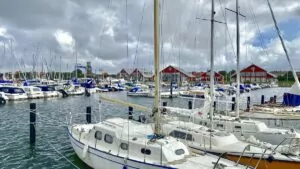

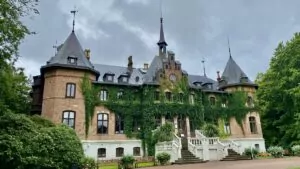
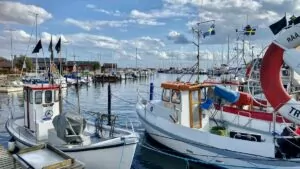
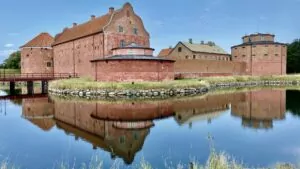
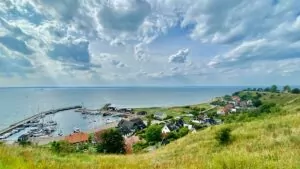
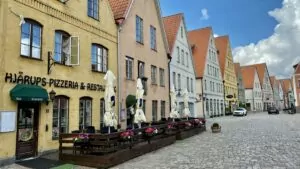
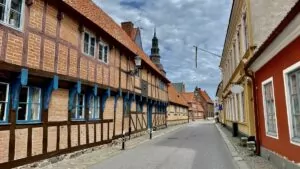
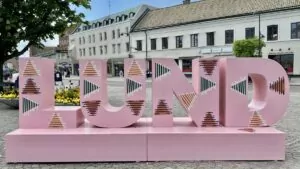
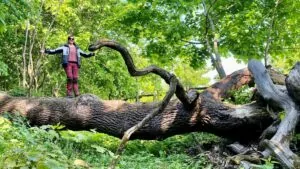
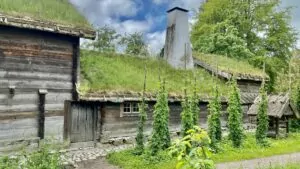
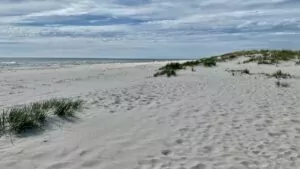
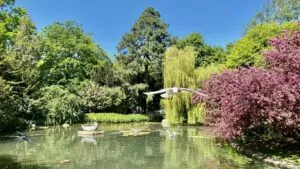
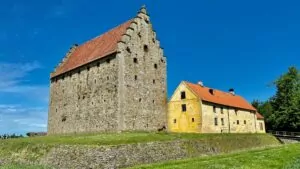
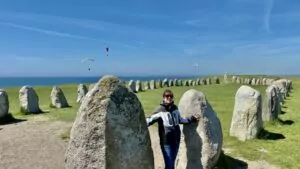
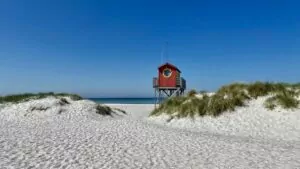
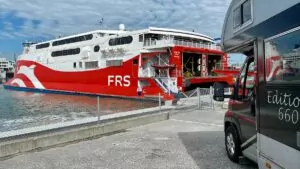
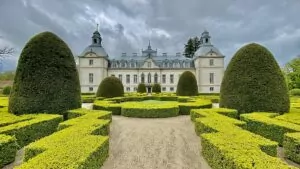
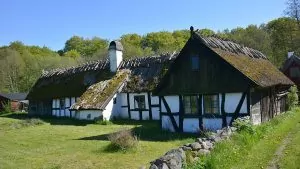
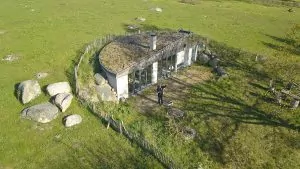
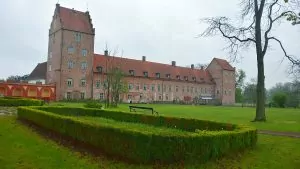
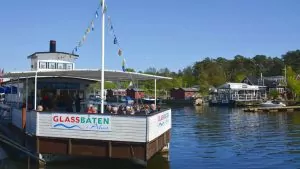
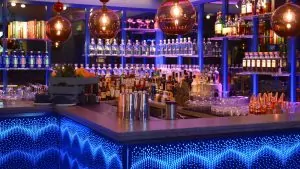
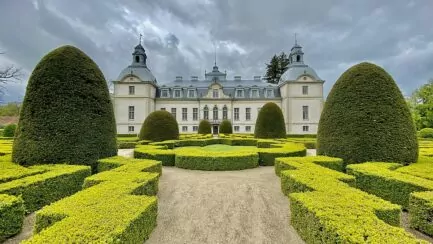
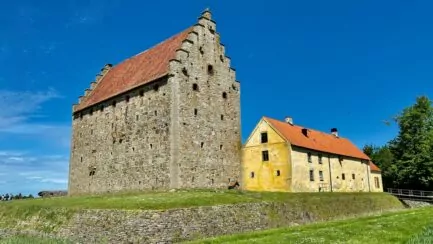
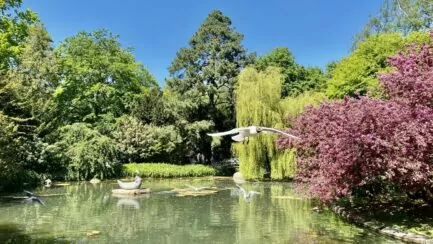
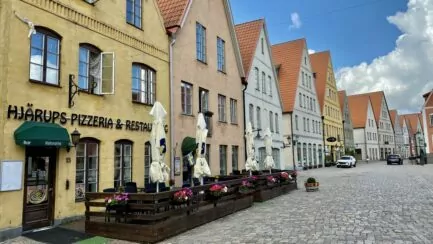
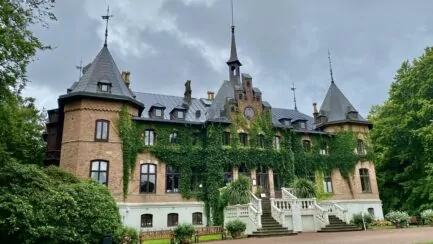
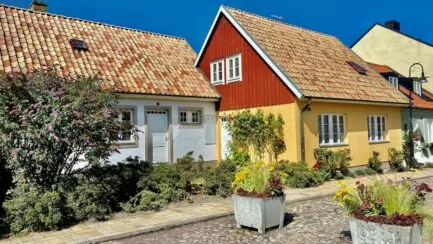



Bear says:
It is not just a rumour, it was Uma Thurman's grandmother Birgit Holmquist, mother of Uma Thurman's mother Nena von Schlebrügge, who was the model for Axel Ebbe's Famntaget.
02 June 2021 - 8:07
Helena says:
Interesting! Thanks for your comment, and further enlightenment! We wrote rumour just because that's what the info sign said, but interestingly, we understand that it's also true!
02 June 2021 - 18:26
Daniela | Discovering The Planet says:
So very nice in this corner of Skåne. Think many miss it in favour of Österlen :). Nice trip you had.
02 June 2021 - 10:57
Helena says:
Yes really very nice! And you may be right, Österlen has a very good reputation, but there are more nice parts of Skåne!
02 June 2021 - 18:27
Daniel on FlyingDryden says:
Yep, did Smykehuk for the first time in 2014 when we did both Kebnekaise, Sweden's lowest point in Kristianstad, Treriksröset, Haparanda, Kosteröarna and Flataklocken (Sweden's geographical centre) in the same year. Have visited Smygehuk twice more since then, most recently this weekend. Nice place and beautiful surroundings, really worth a stop over lunch because even the food was good class, we think!
02 June 2021 - 12:57
Helena says:
You have really done Smygehuk properly! And some other low and high points. Realise we have some points left 😉 Glad to hear it was good food too!
02 June 2021 - 18:28
BP says:
I had never heard of Smygehuk. So I learnt something new there. I like the place. How cosy it looks there. Oh what luck with the weather you had:-)
02 June 2021 - 21:12
Lena+in+Wales+and+Spain says:
Yes, who wouldn't want to visit the southernmost tip of Sweden!
I have a friend in Trelleborg, so we have been there together. Although it was a while ago, we remember walking around and sitting by the water and eating ice cream, good ice cream.
05 June 2021 - 9:55